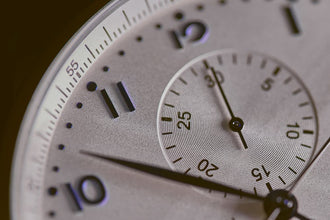

Like all jewellery, you can find watches made of different materials. Silver is one of the most common watch designs, although you don’t tend to find pure silver watches around much in 2022.
Silver is a pretty versatile colour. Silver watches are the perfect choice for everyday wear as well as formal wear - you can wear a luxury silver watch to work, in business meetings, for walks in the park, or even nights on the town.
If you’re considering purchasing a brand new watch or you’re simply interested in finding out about watches, you’re in the right place.
Keep reading to learn all about the different types of silver used in watches, from silver-plated watches to pure silver (fine silver).
Common Types of Silver Used in Watches
The majority of silver watches in 2022 are made of silver alloys such as sterling silver. Silver alloys tend to be a more durable option - and are generally pretty tarnish-resistant. Silver alloys are a popular choice, and there are new silver alloys being created all the time.
Keep reading for some of the most common types of silver that you can find on the market.
Silver Alloy
When you’re browsing the stores or searching online for a watch, you’ll probably see watches that are simply described as ‘silver’.
However, this doesn’t reveal much information about the watch. If you want to understand exactly what the watch is made of, we recommend you speak to the retailer to find out more information about the alloy.
Many people make the mistake of seeing a ‘silver watch’ and assuming that it is made of pure silver. When you see a watch labelled as ‘silver’ with no other information, chances are it’s probably not pure. ‘Silver’ watches are usually silver-plated - but they can consist of silver alloys such as Argentum silver instead.
Sterling Silver
One of the most popular types of silver used in watches and other jewellery is sterling silver. Sterling silver is a less pure type of silver but is super durable. Sterling silver watches are likely to last a long time and are far less likely to get damaged, scratched, or lose their shape from everyday wear.
However, sterling silver has a high percentage of silver - which means that sterling silver watches are still prone to tarnishing. You’ll need to regularly polish this type of watch, although not as much as fine silver watches.
Sterling silver watches will have a stamp engraved on the watch, either on the watch face or inside the bracelet. The stamp should read .925 STG or .925. However, if you come across a vintage watch, the stamp may read STG, STER, or STERLING.
Silver Plating
Silver-plated watches are pretty common - they are watches that have a silver coating but are constructed with a base metal.
They are popular as they offer the luxury appearance of silver without the durability issues that silver watches can present. However, despite having the luxury silver look, silver-plated watches aren’t hypoallergenic.
The main positive of watches with silver plating is that they are generally pretty affordable, and look just like pure silver watches.
Rare Types of Silver Used in Watches
Some types of silver are less commonly used in watches - for example, pure silver was historically used in watches as it was the best metal of the time. However, times have changed and there are stronger alternatives available in 2022.
Pure Silver
Historically, watches were made using silver - especially pocket watches. However, there are some downsides to using pure silver in watches. Fine silver is a very soft metal which means that it can be easily damaged and scratched, and can lose its shape through everyday wear.
Because silver isn’t a durable material, it’s usually lower impact jewellery such as earrings that are made of silver as opposed to watches and bracelets.
Silver also tarnishes, which means that it needs to be polished regularly. If you’ve ever had to polish silverware, you’re probably aware that it’s a tedious task. However, fine silver looks high-quality - the quality of silver is unparalleled.
It has a shiny white colour and has a luxury feel - and it is hypoallergenic meaning it won’t affect the skin. When looking for silver watches, be sure to check the stamp - fine silver watches will have a stamp engraved on the watch - usually on the inside. Look out for the stamp .999 or .000FS.
Coin Silver
Another rare type of silver watch that you may come across is coin silver. Although pretty rare, it’s a more affordable type of silver that watches can be made of.
The purity content is usually around 90% pure silver. Although it’s rather rare in 2022, it was once one of the most common silver alloys.
Just like fine silver watches, coin silver can tarnish pretty easily. This means that you’ll have to polish the watch regularly and be sure to take care when wearing it. Coin silver watches aren’t recommended for everyday use, as they can be more prone to damage than other silver alloys.
You can tell if a watch is made of coin silver as it will have a .900 stamp - whereas fine silver will have a .999 stamp.
Argentium Silver
When browsing for silver watches, you may have come across the term ‘Argentium Silver’. Argentium is a brand name, so is less seen in jewellery and watch stores. This means that only authorised watchmakers can use the Argentium stamp.
Argentium isn’t as pure as some other types of silver but is still pretty pure with two different purity grades - either 96% or 93.2%. It’s a more modern type of silver, with a rise in usage over the last couple of years.
The main benefits of Argentium are that silver watches are reliable, easy to look after, tarnish-resistant, and hypoallergenic - just like pure silver.







